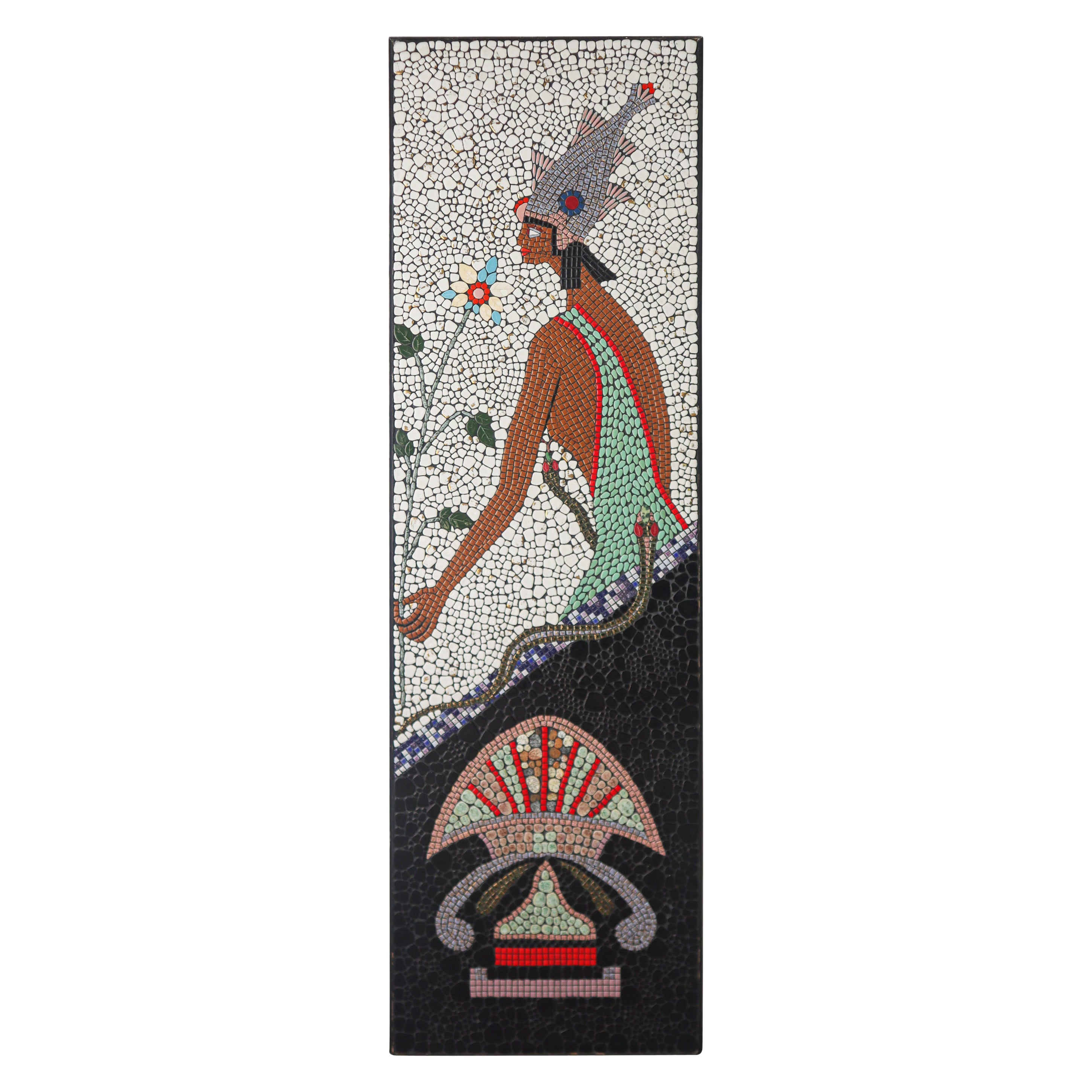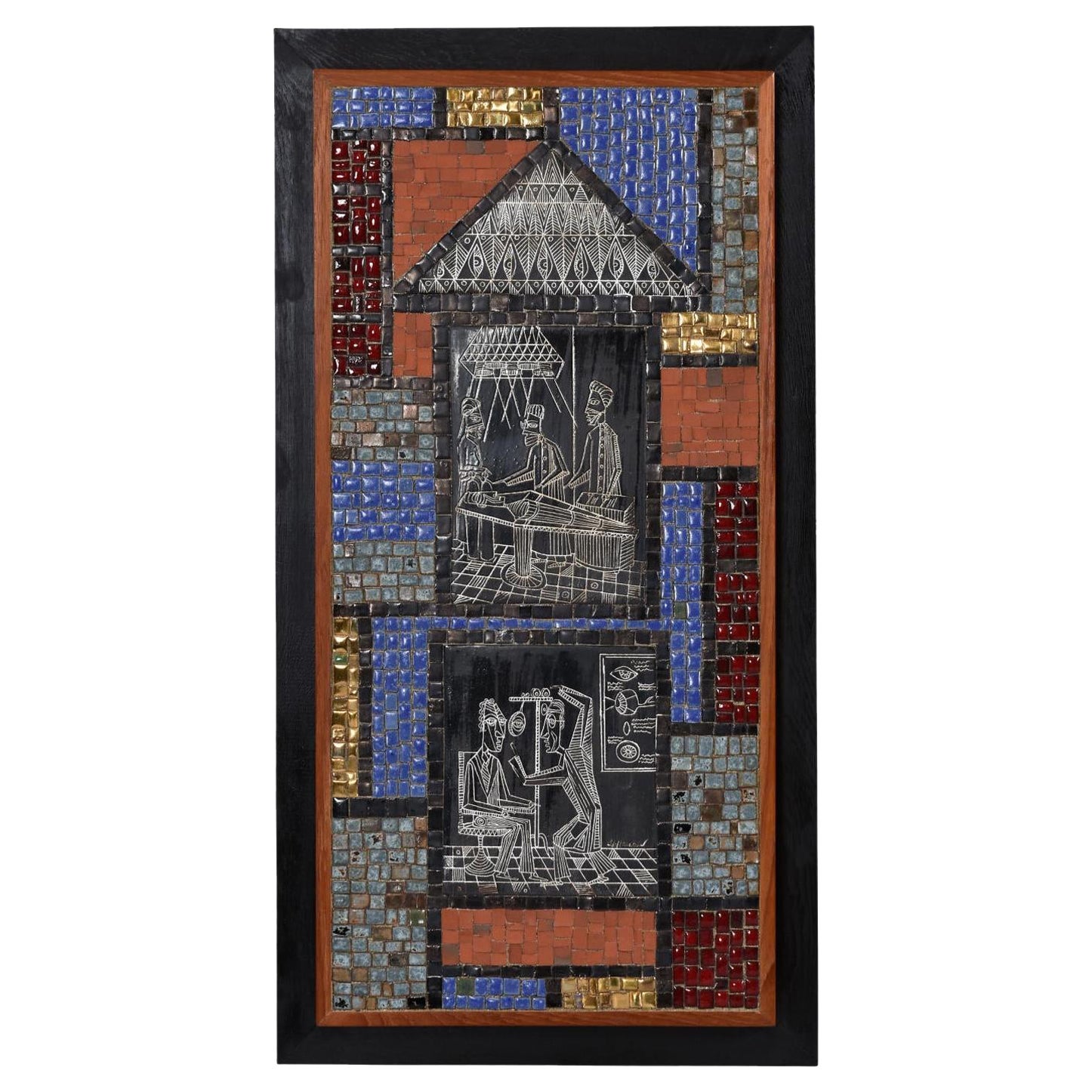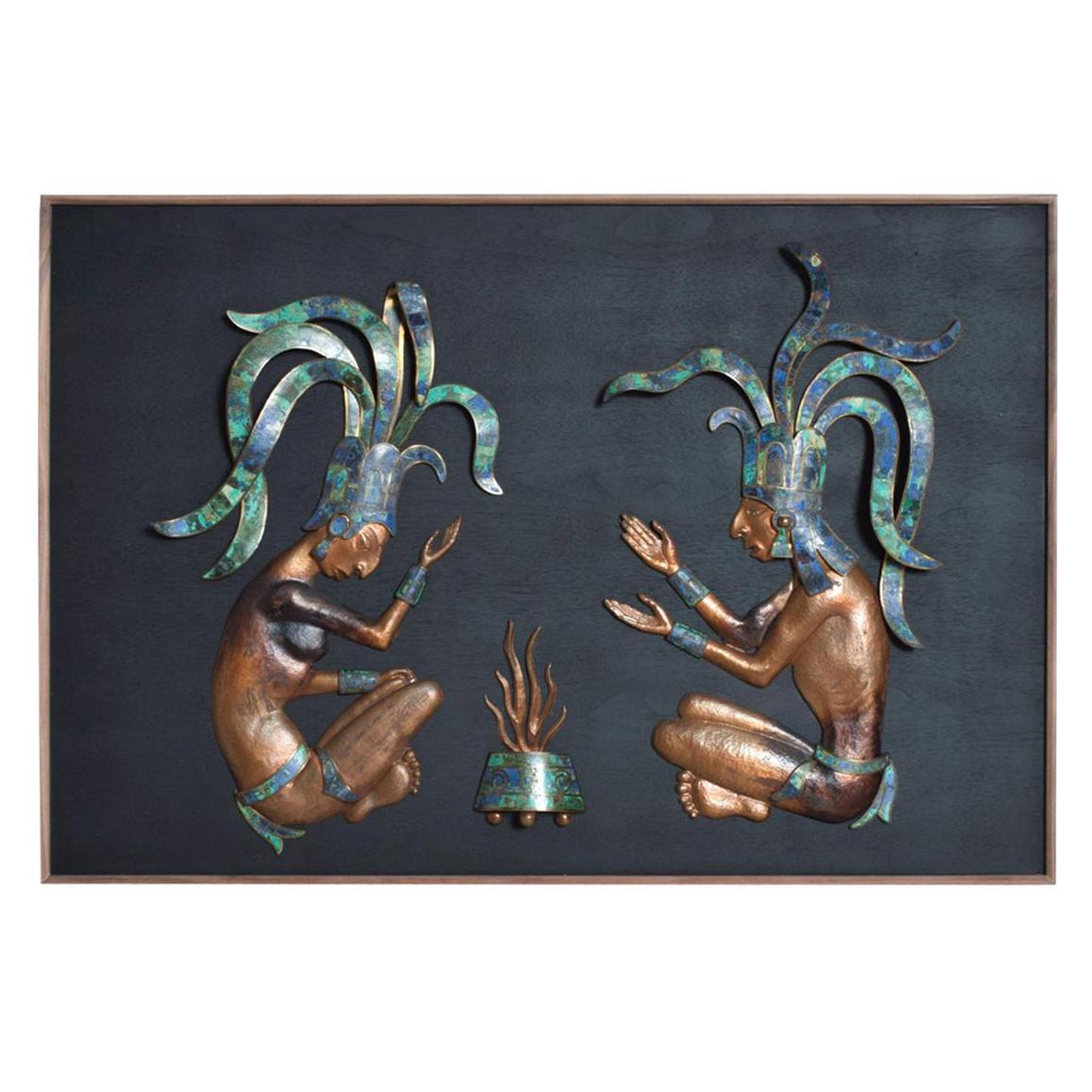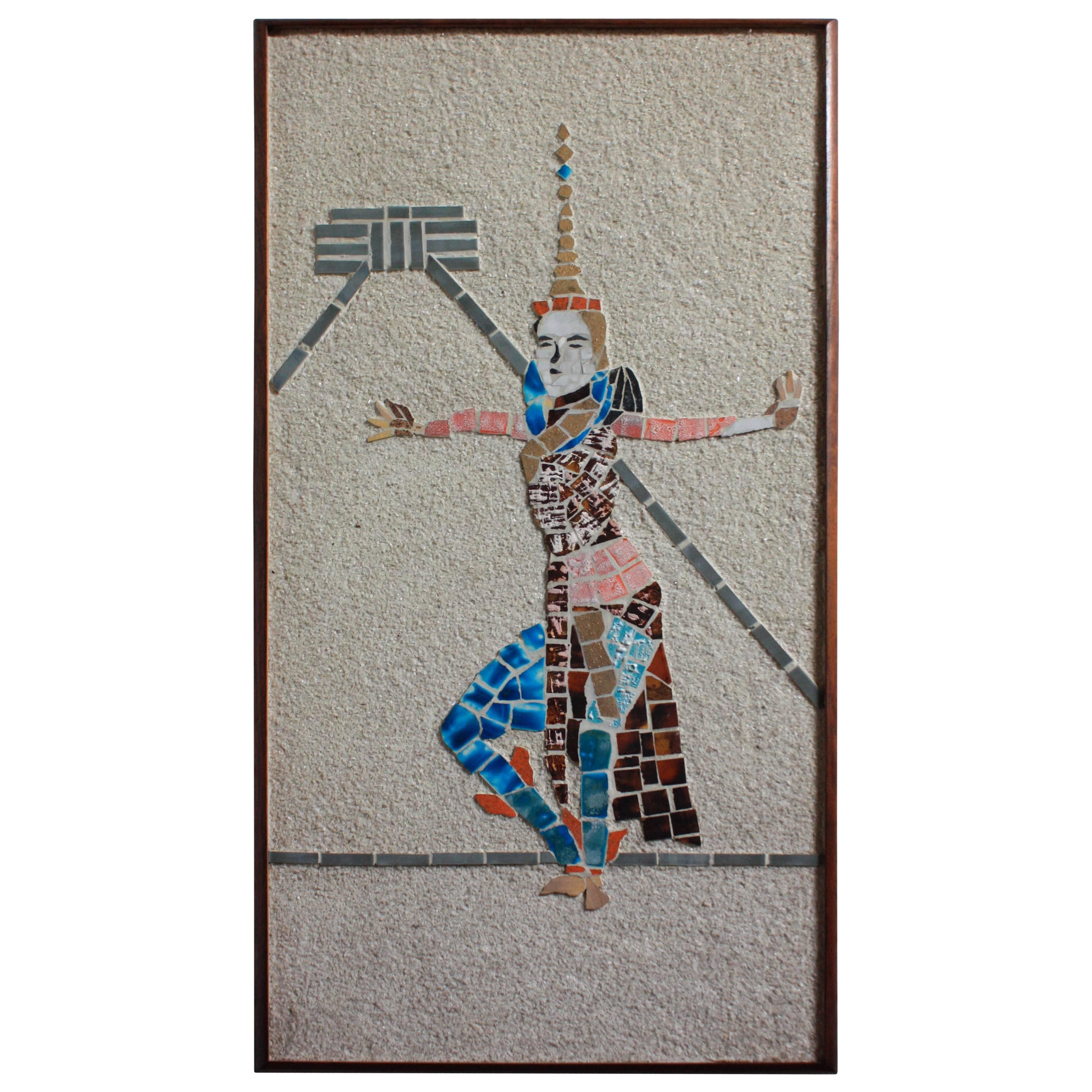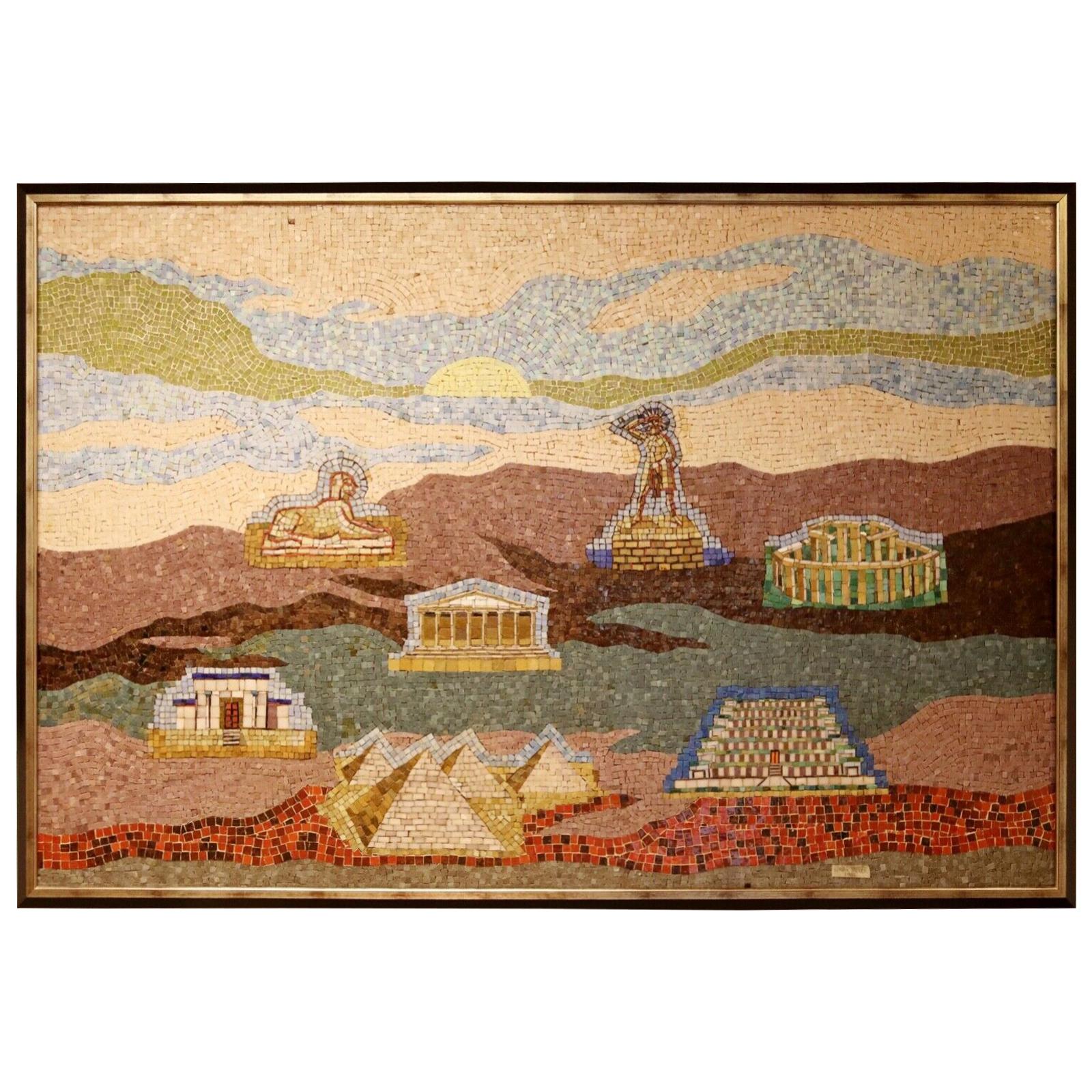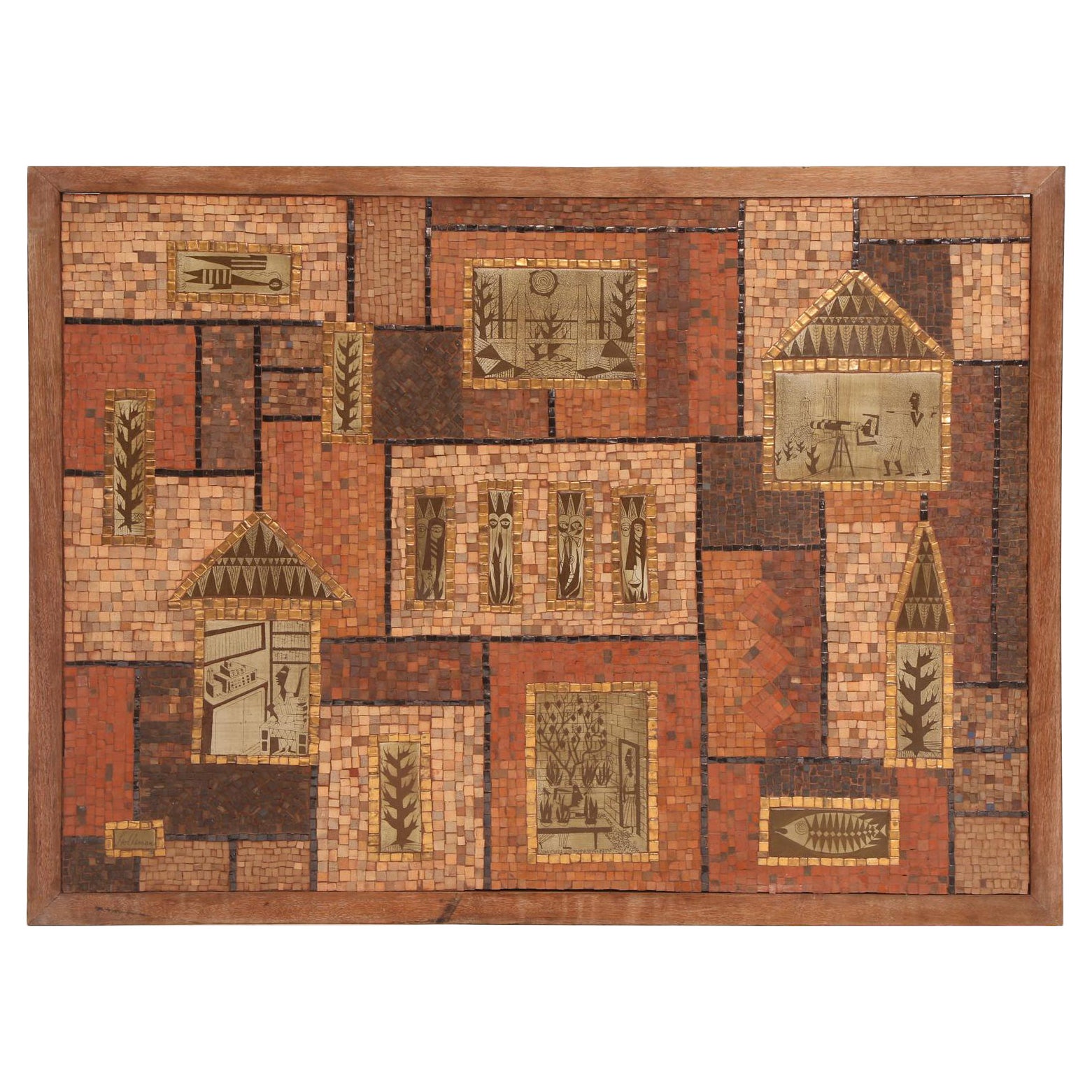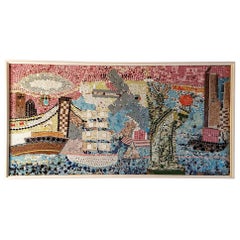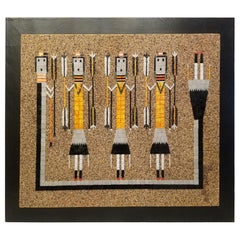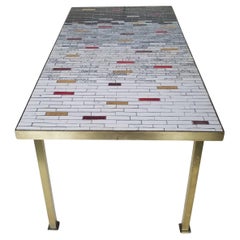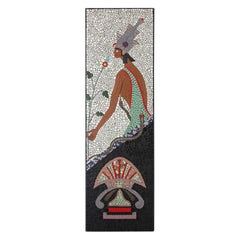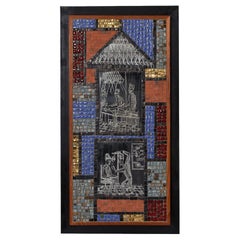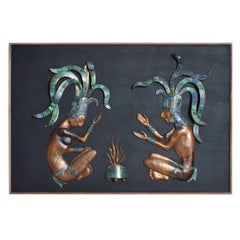Items Similar to Los Castillo E.Alvarado Arquitectura Mosaic with Montezuma Mexico, 1959
Want more images or videos?
Request additional images or videos from the seller
1 of 11
Los Castillo E.Alvarado Arquitectura Mosaic with Montezuma Mexico, 1959
$7,500
£5,734.15
€6,604.58
CA$10,509.80
A$11,733.20
CHF 6,148.02
MX$143,625.92
NOK 78,079.94
SEK 73,619.47
DKK 49,290.67
Shipping
Retrieving quote...The 1stDibs Promise:
Authenticity Guarantee,
Money-Back Guarantee,
24-Hour Cancellation
About the Item
An E. Alvarado 1959 mosaic wall panel commissioned at the Taxco showroom of Los Castillo Plateros depicting the 1467 reconstruction of the temple of Huitzilopochtii after its damage from an earthquake overseen by Montezuma.
E. Alvarado’s work reflects a deep reverence for Mexico’s indigenous history, blending traditional iconography with the modernist aesthetic of the mid-20th century. This panel was created in 1959, during a period of renewed interest in Mexico’s pre-Hispanic roots and national identity, contributing to the reconstruction efforts that sought to honor and preserve historic architecture. The intricate mosaic construction, with its vivid hues and detailed craftsmanship, exemplifies Los Castillo’s mastery and dedication to cultural storytelling through art.
The piece exudes historical gravity and artistic brilliance, making it a significant collectible for historians, art enthusiasts, or collectors of Mexican modernist art.
It is a stunning testament to Mexico’s enduring legacy and artistic innovation.
The mosaic is composed of hand shaped pieces of turquoise, amethyst, obsidian, sea green opal, tourmaline, lapis lazuli, limestone and other stones set into a thick plaster backing.
The Alvarado mosaic studio was located on the second floor of the Los Castillo Plateros showroom in Taxco, Mexico.
The original owners met with E. Alvarado at his workshop and chose this scene from the many offered. They returned to Boston and received a drawing and a small bag of various semi-precious stones that were samples of what the mosaic would be made from. A couple of weeks later they received a photographic update on the progress of the mosaic with the final artwork shipped to them a month after their meeting with Sr. Alvarado.
The cost of the mosaic with its shipment in 1960 was twelve hundred dollars the equivalent of almost thirteen thousand dollars today.
Below are excerpts from the final letter to the original owners informing them of the impending shipment to their home in Boston and reviewing the historical event illustrated by their mosaic.
"The description of the "ARQUITECTURA" mosaic is:
Fifty two years before Cortéz arrived in what is now México City there was an earth quake which partly destroyed the Main Temple of the Aztecs dedicated to Huitzilopochtli (God of War).
The Emperor Montezuma, who is represented in the low right hand corner of the plaque had it reconstructed.
The reconstruction required hundreds of men, but since this mosaic is an allegory, the artist, E. Alvarado, tries to carry the message by using a few men to sculpture the Idol, a man is cracking the stone, another man is carrying up the stairway of the Pyramid, another man is making a dugout to embark into one of the many channels and lagoons that existed in the Valley of México in the sixteenth century. The lake and channels are represented by the Sea Green Opal, the artist has emphasized this point, in view that the water transportation was the preferred way to travel.
To wash this mosaic kindly use
a hard bristle brush using any kind of detergent, scrub it entirely and then wash it until the plaque is free
from detergent.
This operation should be done once every 6 months.
clean it ordinarily just brush it."
The mosaic is in fine vintage condition as pictured.
E. Alvarado was a talented mosaic artist associated with Los Castillo, a renowned Mexican workshop celebrated primarily for its silverwork and decorative arts. While detailed biographical information on E. Alvarado is limited, it’s known that Los Castillo collaborated with various skilled artisans, including mosaic artists, during the mid-20th century, often working on culturally significant projects that emphasized Mexican history, architecture, and indigenous motifs.
Alvarado contributed to the workshop’s legacy by creating intricate mosaic panels that reflected Mexico’s rich cultural and historical themes, such as the reconstruction of ancient landmarks like the Main Pyramid in Mexico City. His work is characterized by vibrant colors, detailed iconography, and a clear reverence for traditional Mexican artistic motifs. The mosaic from 1959 exemplifies his craftsmanship and dedication to preserving Mexican heritage through art.
While specific biographical details remain scarce, his association with Los Castillo and his work on this significant panel position him among the talented artisans shaping Mexico’s artistic revival in the mid-20th century. His contributions continue to be appreciated by collectors and historians for their craftsmanship and cultural significance.
- Creator:Alvarado (Artist),Los Castillo (Retailer)
- Dimensions:Height: 31 in (78.74 cm)Width: 40.5 in (102.87 cm)Depth: 2 in (5.08 cm)
- Style:Mid-Century Modern (Of the Period)
- Materials and Techniques:Amethyst,Brass,Carnelian,Celadon,Lapis Lazuli,Limestone,Malachite,Multi-gemstone,Opal,Plaster,Rose Quartz,Tourmaline,Hand-Crafted,Mosaic
- Place of Origin:
- Period:
- Date of Manufacture:1959
- Condition:Wear consistent with age and use.
- Seller Location:Camden, ME
- Reference Number:1stDibs: LU898444151612
About the Seller
5.0
Platinum Seller
Premium sellers with a 4.7+ rating and 24-hour response times
Established in 1984
1stDibs seller since 2010
236 sales on 1stDibs
Typical response time: 1 hour
- ShippingRetrieving quote...Shipping from: Camden, ME
- Return Policy
Authenticity Guarantee
In the unlikely event there’s an issue with an item’s authenticity, contact us within 1 year for a full refund. DetailsMoney-Back Guarantee
If your item is not as described, is damaged in transit, or does not arrive, contact us within 7 days for a full refund. Details24-Hour Cancellation
You have a 24-hour grace period in which to reconsider your purchase, with no questions asked.Vetted Professional Sellers
Our world-class sellers must adhere to strict standards for service and quality, maintaining the integrity of our listings.Price-Match Guarantee
If you find that a seller listed the same item for a lower price elsewhere, we’ll match it.Trusted Global Delivery
Our best-in-class carrier network provides specialized shipping options worldwide, including custom delivery.More From This Seller
View AllMosaic Panel of the Bicentennial in New York Harbor, 1978
Located in Camden, ME
A large mosaic panel artwork representing the bicentennial celebration in New York harbor on the evening of July 4, 1976.
A memorable evening throughout the United States and partic...
Category
Vintage 1970s American Mid-Century Modern Outsider and Self Taught Art
Materials
Ceramic
$7,200 Sale Price
68% Off
California Studio Navajo Sand Painting Mosaic Art Panel of Thunderbird, 1960s
By I. D. Henny
Located in Camden, ME
A Navajo sand painting mosaic art wall panel of the Navajo mythological Father Sky or Thunderbird created in the 1960s in a non traditional format...
Category
Mid-20th Century American Mid-Century Modern Decorative Art
Materials
Ceramic
California Studio Mosaic Navajo Sand Painting Yei Dancers Rainbow 1960 Guardians
By I. D. Henny
Located in Camden, ME
A Navajo sand painting mosaic art wall panel of the Navajo mythological Yei Dancers Rainbow Guardians created in the 1960s in a non traditional fo...
Category
Vintage 1960s American Mid-Century Modern Decorative Art
Materials
Stone
Hand Crafted Mosaic Tile Brass Framed Coffee Table York City Studio, c. 1950
By Clay Mosaics & Ceramics Inc. NY
Located in Camden, ME
An early 1950's custom designed coffee table created at the Clay Mosaics & Ceramics, Inc. studio which was located at 432 East 82nd Street in New York.
The gradual change of the col...
Category
Vintage 1950s American Mid-Century Modern Coffee and Cocktail Tables
Materials
Brass
Mosaic of a Jean Dufy Paris Street Scene Watercolor c. 1950
By Jean Dufy
Located in Camden, ME
A wonderful mosaic of ceramic and iridescent tile that captures the vitality and color of a neighborhood in Paris with small shops, a cafe, a pharmacie, along a tree lined boulevard ...
Category
Mid-20th Century French Mid-Century Modern Decorative Art
Materials
Ceramic, Art Glass
Salvador Corona Folding 4 Panel Floor Screen of Patzcuaro, Acapulco circa 1938
By Salvador Corona
Located in Camden, ME
Salvador Corona painted four-panel wooden floor screen created in his studio in Mexico circa 1938.
This rare hand crafted multi medium room divider was the property of the daughter of one of Mexico's wealthiest families of the period, who married the head of an international railroad supply company in their Warren McArthur furnished apartment on Park Avenue.
The custom designed Warren McArthur furniture was a gift of the Pullman Company.
In the early 1950s she opened a shop in Boothbay, Maine and later on upper Lexington Avenue specializing in the crafts of Mexico.
This may have been a wedding present to her from the artist, her family or a close friend.
The screen shows a the harbor of 19th Century Acapulco with the major buildings with gold leaf tiled roofs, Spanish galleons in the bay, a whale spouting in the distance, birds, and silver leafed palm trees .
The harbor scene is bordered in gilt painted cord. Within which are appliquéd cutout medallions of various local fish and air bubbles covered in tinfoil ,a new material in the 30s. The tinfoil is finely etched in a variety of intricate patterns. Some of the appliqués are glazed in gold.
The reverse side of the screen is an ivory white back ground with vignettes from the Maximilian era of Mexico.
The screen is in good condition with wear consistent with its age.
Salvador Corona was born on his family's ranch Hacienda Mideras in the Mexican state of Chihuahua. Corona’s family moved to Mexico City in 1903 when he was 8. He attended the New English College in Mexico and then crossed into a career in bull fighting entering the ring for the first time in 1913. In 1919 in Guadalajara he was gored and turned to painting.
He was given his first painting lessons by fellow bullfighter Jose Jimenez.
Corona’s painting career spanned many decades and diverse formats including murals, furniture and decorative household items.
In 1939, the Mexican government invited him to exhibit a set of painted furniture at it's booth at the World’s Fair in New York City. There, it was presented to President Franklin D. Roosevelt as a gift. Corona’s work attracted many famous patrons, including the Duchess of Windsor, Gary Cooper and writer Clare Booth Luce.
Salvador Corona’s work featured many Spanish Colonial vignettes, and he became an authority on Spanish and French costumes of the 1800s, which are frequently depicted in his paintings. His favorite subjects often included Mexican Colonial criollos and Purepecha (Tarascan) Indians. Birds and other animals feature prominently in his work.
His traditional self-developed folk art style images depicted pastoral colorful scenes of Maximilian era Mexico painted on white backgrounds.
His work can be divided into three categories: a vice-regal era with European and Creole noblemen mixed with Indians; stylized landscapes of Patscuaro, Acapulco or the Canal of Santa Anita; and his iconographic Mexican Virgins...
Category
Vintage 1930s Mexican Rancho Monterey Screens and Room Dividers
Materials
Foil, Gold Leaf
$20,000 Sale Price
52% Off
You May Also Like
Mid-Century Egyptian Goddess Mosaic
Located in Las Vegas, NV
Unique mid-century mosaic depicting and Egyptian Goddess, possibly Hatmehyt, the Egyptian Goddess of Fish.
The mosaic stands 6.5ft tall and is constructed out of rounded pebble l...
Category
Mid-20th Century Mid-Century Modern Decorative Art
Materials
Stone
David Holleman Mosaic Tile Art Panel with Sgraffito Illustratration
By David Holleman
Located in Chattanooga, TN
Mid-Century Modern era mosaic tile art panel by celebrated artist, David Holleman (1927-2020). Holleman is a prolific artist with a storied career spanning the better part of the 20th century and into the 21st. During his time serving with the US Army in Berlin, he became influenced by German Expressionist painter Carl Hofer. Once Holleman returned to the US he turned to ceramics as his primary medium. Despite winning national prizes for his pottery, he endeavored to further explore the medium. Holleman began working with his hallmark, mosaic tiles. Holleman produced over 50 mosaic tile murals...
Category
Mid-20th Century American Mid-Century Modern Decorative Art
Materials
Wood, Paint, Ceramic
1980s Mexico Modernism Metal Wall Art Panel Mosaico Azteca
By Los Castillo
Located in Chula Vista, CA
1980s Mexico Modernism Wall Art Panel attributed Los Castillo
unmarked
Mixed Metals Malachite -Azurite Stone Mayan design.
New wood in solid walnut.
Be...
Category
Vintage 1980s Mexican Modern Wall-mounted Sculptures
Materials
Malachite, Bronze
Richard Hohenberg Mosaic
By Richard Hohenberg
Located in Brooklyn, NY
This Hohenberg Mosaic depicts a classical Thai dancer and is comprised of glass and ceramic tiles against a crystalline incrustation. The frame is solid walnut and the piece is stencil signed on the reverse 'Hohenberg Original.'
Category
Vintage 1950s American Mid-Century Modern Wall-mounted Sculptures
Materials
Ceramic, Glass, Walnut
$2,900
Edgar Louis Yaeger World Wonders Modern Mosiac, 1986
By Edgar Yaeger
Located in Keego Harbor, MI
For your consideration is a monumental mosiac mural of world wonders made in 1986 by Michigan artist Edgar Louis Yaegar (51x74). Edgar Louis Yaeger was a...
Category
Vintage 1980s American Contemporary Art
Materials
Other
David Holleman 1960's Mosaic Wall Art
By David Holleman
Located in Phoenix, AZ
Large-scale David Holleman mosaic wall art, circa early 1960s. This work entitled 'Cityscape' is one of the larger examples of Holleman's work ever off...
Category
Vintage 1960s American Mid-Century Modern Wall-mounted Sculptures
Materials
Ceramic
More Ways To Browse
Water Opal
Mexican Turquoise
Sea Bag
Amethyst Mexican
Vintage Wall Plaques
Los Castillo Brass
Aztec Stone
Brass Couple Sculpture
Pyramid Bag
Malachite Pyramid
Los Castillo Vintage Modernist
Mexican Brass Turquoise
Los Castillo Mosaic
Aztec Obsidian
Rose Castillo
Starburst Band
Top Hat Box
Vintage 2 Door Metal Cabinet
